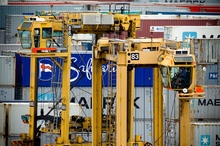Jun 19, 2014

New Zealand recorded a $1.4 billion current account surplus in the March quarter.
The largest ever, buoyed by strong export volumes of meat and dairy products and the most favourable terms of trade for 40 years.
Quarterly surpluses are rare; there have only been six in the past 10 years. The March quarter’s surplus lowered the annual current account deficit to $6.3 billion, equivalent to 2.8 per cent of gross domestic product, the lowest that ratio has been for three years.
While economists expect the deficit to narrow further on an annual basis in the June quarter, they warn it will widen again later in the year.
See the Statistics NZ release here:
The terms of trade is expected to decline, with dairy prices 25 per cent below their February peak and oil prices at risk from events in Iraq.
Net exports are expected to fall in volume terms as the Canterbury rebuild pulls in imports and exporters battle a stubbornly high dollar.
And the investment income balance will sink deeper into the red as interest rates rise.
In the meantime, though, there was a lot to like in the March quarter’s numbers, Westpac economist Michael Gordon said: “Another record trade surplus
The investment income deficit was $2.7 billion, making $9.9 billion for the year. Foreign-owned companies, including the big four banks, made $2.4 billion in profits in the March quarter, of which just over half was reinvested.
Gordon expects the annual current account deficit to settle around 4 per cent of GDP over the longer term – a far cry from levels approaching 8 per cent of GDP seen in 2006 and 2008. “We believe there’s been a step change in New Zealand’s export performance, due to greater engagement with the fast-growing Asian markets in the last few years. And we don’t see scope for another debt-fuelled spending binge, given the already high level of household debt.”
Meanwhile, New Zealand’s net liabilities to the rest of the world have increased by $1.1 billion to $148 billion. Measured against the size of the economy, however, the net international liability position has improved to 65.3 per cent of GDP from 66.4 per cent in December 2013 and a peak of 85.9 per cent five years ago.
That is flattered by including as New Zealand assets overseas $4.8 billion of reinsurance claims still to be settled. But even excluding them from the calculation the net liability position is the best it has been, relative to GDP, for more than 10 years.
Bank of New Zealand economist Craig Ebert said much of the balance sheet improvement reflected a reduction in gross foreign debt, which has fallen to 110 per cent of GDP from 140 per cent back in 2009.
And that is despite an increase in public sector debt as the Government’s balance sheet took the strain of recession and the Canterbury earthquakes.
Ebert estimates the private sector’s net debt abroad has shrunk to 58.3 per cent of GDP, from an 89.9 per cent peak five years ago.
It now takes just 9.1 per cent of the income from exports of goods and services to pay the interest on the country’s net foreign debt – the lowest that ratio has been since Statistics New Zealand started recording it in 1993 and less than half its level just before the global financial crisis.
“Of course, we have to be careful that this debt servicing ratio reflects cyclical highs in export prices and cyclical lows in interest rates,” Ebert said. “Nonetheless, it is evidence that New Zealand has much improved its external buffers …”
Trading up
• $1.4b record current account surplus in the March quarter.
• $6.3b annual current account deficit equivalent to 2.8% of GDP, the lowest that ratio has been for three years.
• Result buoyed by strong export volumes of meat and dairy products.
• Economists expect annual deficit to narrow further in the June quarter, before widening later in the year.
